Publications
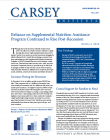
November 1, 2011
This brief uses data from the 2007, 2009, and 2010 American Community Survey to provide an up-to-date look at changes in SNAP receipt over the course of the recession. The author reports that receipt of SNAP continued to rise in 2010, increasing 4 percentage points since the recession began in 2007, and 1.6 percentage points since 2009.
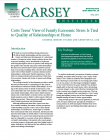
October 25, 2011
Family economic hardship during adolescence affects family relationships and the social, emotional, and behavioral development of a substantial number of American youth.
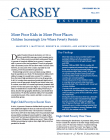
October 18, 2011
The authors of this brief examine child poverty rates using decennial census data from 1980, 1990, and 2000, as well as American Community Survey five-year estimates between 2005 and 2009, to identify those counties where child poverty has persisted. They find persistent child poverty in nearly twice as many U.S. counties as those that report high persistent poverty across all age groups. In all…
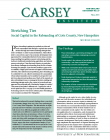
October 5, 2011
Place rebranding is gaining in popularity as cities and rural communities alike attempt to expand their revenue streams through innovative marketing strategies that seek to revitalize or create tourism destinations. These efforts tend to come about as part of an economic development strategy pursued by communities that have borne steep economic losses resulting from global economic restructuring…
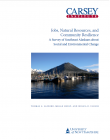
September 27, 2011
As part of the Community and Environment in Rural America (CERA) project, researchers at the Carsey Institute surveyed 1,541 residents of the ten boroughs and unincorporated census areas in Southeast Alaska to better understand social and environmental change in the region and their implications for Alaskan community and families. The authors of this brief report that social problems in the…
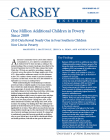
September 22, 2011
American Community Survey (ACS) data released on September 22, 2011 allow for a detailed look at child poverty by state and place, adding to the understanding of the economic landscape described by the Current Population Survey (CPS) data released last week. While the CPS data are useful for providing a snapshot of poverty across the nation, the larger sample size of the ACS--three million…
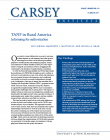
September 20, 2011
In 1996 welfare reform ushered in a new era in which cash assistance for poor parents became both temporary and conditional on activities to promote economic independence through work. Cash assistance from TANF relieves, but does not eliminate, poverty because benefit levels are far too low to lift families above the poverty threshold. These ameliorative effects are weaker in rural than urban…
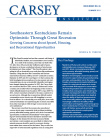
September 6, 2011
In May and June of 2007, Carsey Institute researchers surveyed 1,000 randomly selected respondents from Kentucky’s Harlan and Letcher counties, and between November 2010 and January 2011, they returned to survey 1,020 different randomly selected respondents from the same counties. These two Kentucky counties provide a snapshot of perceptions of community and environmental change in a chronically…
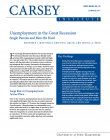
August 31, 2011
This brief discusses the sweeping impact the Great Recession has had on Americans, particularly men, single parents, young adults, and people with less education. Using data from the 2007 and 2010 Annual Social and Economic Supplement of the Current Population Survey, the authors report that unemployment is highest among men and among unmarried adults, regardless of place or parenting status.…
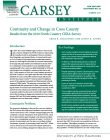
August 2, 2011
This brief from Chris Colocousis and Justin Young uses the most recent North Country CERA survey to focus on change and continuity in Coos County between 2007 and 2010, and then makes comparisons of the present conditions across the three study counties. The authors examine such topics as community problems, environmental and economic concerns, and community cohesion and confidence in the local…
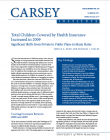
July 27, 2011
This brief uses data collected in 2008 and 2009 from the U.S. Census Bureau's American Community Survey (ACS) to examine changes in overall insurance coverage rates, as well as changes in types of coverage, and differences by region, state, and place type. The data show that together with new and more inclusive parameters for children's health insurance coverage, rates of children…
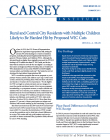
July 19, 2011
This brief uses data from the 2007 and 2010 Current Population Survey’s Annual Social and Economic Supplement to describe the distribution of the Special Supplemental Nutrition Program for Women, Infants, and Children (WIC) receipt across the population and to detail place-based differences in receipt. WIC is a nutrition program that serves pregnant or postpartum women, infants, and children up…
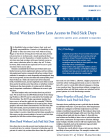
July 12, 2011
This brief, using data from the 2008 National Study of the Changing Workforce (NSCW) survey, analyzes paid sick time rates of workers by place and type of work. Paid sick days provide job protection to workers and a steady paycheck when they need to care for themselves or family members. Paid sick days also help workers with more limited resources who cannot otherwise afford to take a day off.…
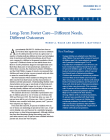
June 21, 2011
This brief examines where foster children are living four years after removal from their homes and the characteristics of these children and their placements. Understanding whether child characteristics such as age or emotional or behavioral problems are associated with a longer stay in out-of-home care can help identify children who are least likely to find permanence and may benefit from…
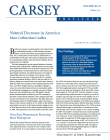
June 14, 2011
This brief summarizes recent regional patterns of natural decrease in the United States. Natural decrease occurs when more deaths than births occur in an area in a given year. The growing incidence of natural decrease has gone largely unnoticed, yet natural decrease is no longer an isolated phenomenon occurring in a few remote corners of the country. Last year, 24 percent of all U.S. counties…
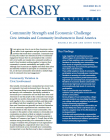
June 7, 2011
Residents in rural areas that are rich in amenities report a positive outlook about their community strength and civic engagement, with nine out of ten saying they would work together to solve a community problem. However, residents in chronically poor rural communities are less likely to trust, get along with, and help their neighbors. Michele Dillon, professor of sociology at UNH and faculty…
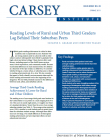
May 10, 2011
This brief examines the complex interplay of family, school, and place factors in the reading achievement levels of third grade students. Third grade reading achievement is critical to later academic and occupational success. Using data from the Early Childhood Longitudinal Study, the authors report that suburban children realize greater gains in reading achievement from kindergarten to Grade 3…
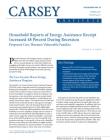
May 3, 2011
This brief examines heating assistance usage and the implications of President Obama's 2012 budget proposal to cut $2.5 billion from the $5.1 billion energy assistance fund for low-income families at a time when families are struggling with higher energy costs amid a difficult economy. The federal Low-Income Home Energy Assistance Program (LIHEAP) assists vulnerable families in paying their…
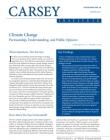
April 19, 2011
In 2010, Carsey Institute researchers began including three new questions about climate change on a series of regional surveys. They asked how much people understand about the issue of global warming or climate change; whether they think that most scientists agree that climate change is happening now as a result of human activities; and what they believe personally about the topic. Survey results…
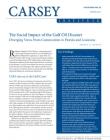
April 12, 2011
Carsey researchers surveyed over two thousand residents of the Gulf Coast following the BP Deepwater Horizon oil rig explosion in 2010 to analyze their perception of the spill. Nearly one-half of all Gulf Coast residents perceived damage to the environment and wildlife as the most serious result of the oil spill. Perceptions regarding the impact of the spill reflect the different relationships to…